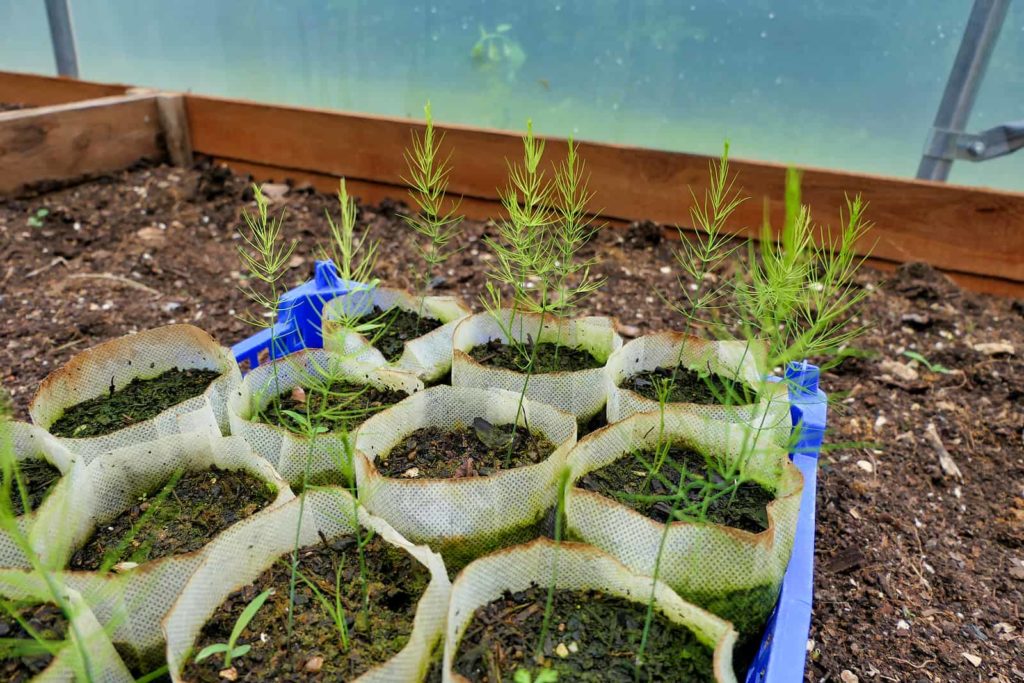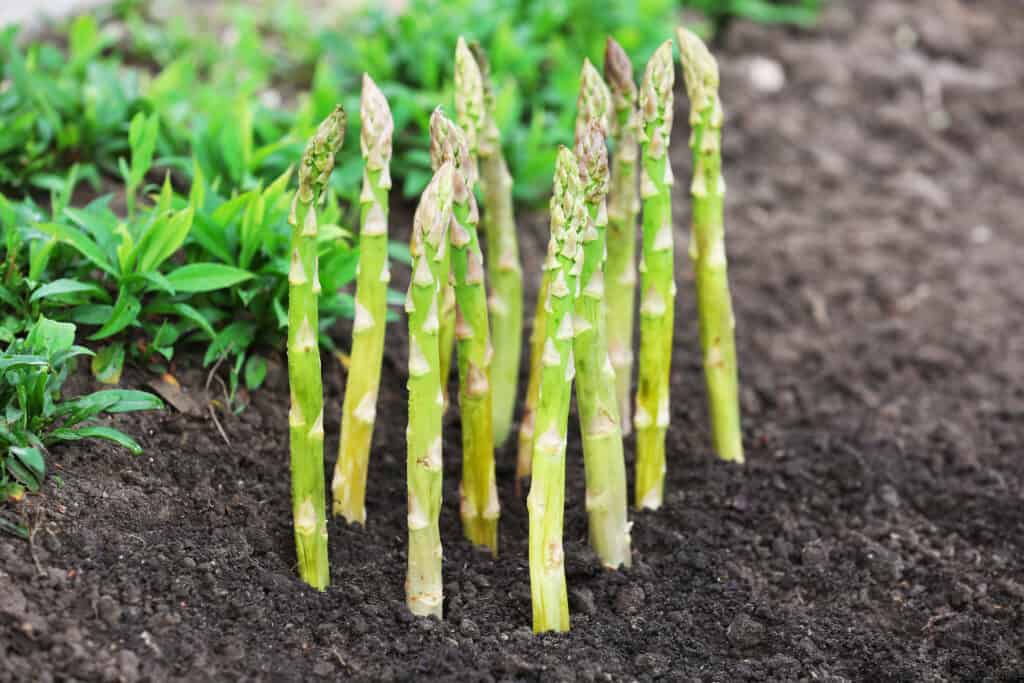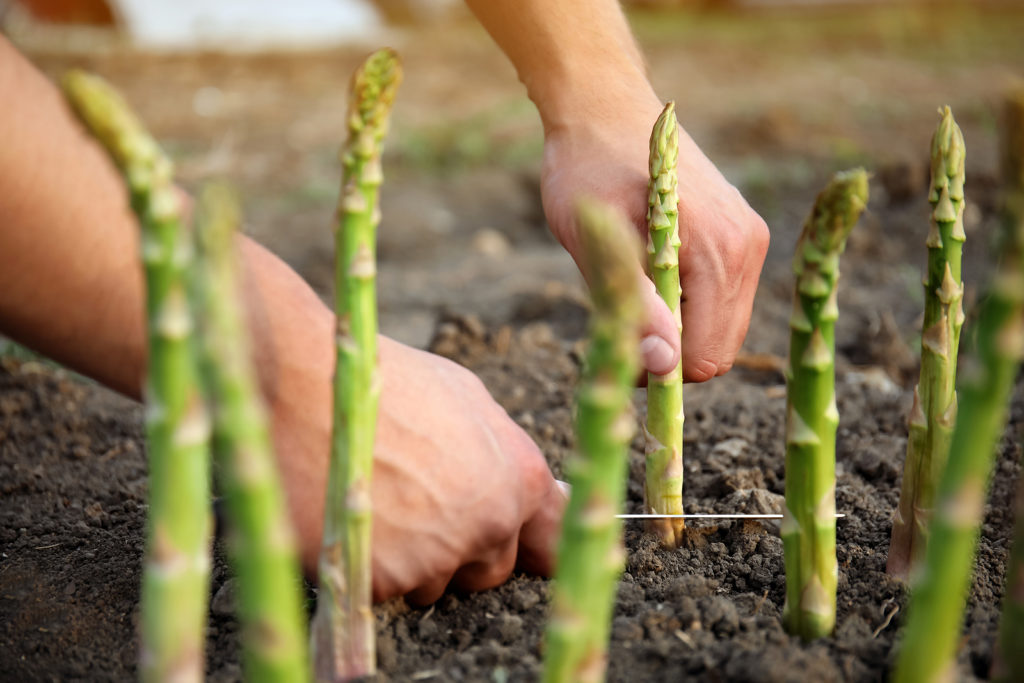Asparagus is a perennial plant. Plant asparagus where it can grow undisturbed and be productive for 15 to 20 years.
Asparagus can be started from seeds or crowns. Plants grown from seed commonly produce a larger number of slightly bigger and more tender spears.
Set out seedlings 12-inch seedlings 4 weeks after the last frost. Sow seeds indoors 12 to 14 weeks before planting out. Soak seeds overnight in tepid water to improve germination.
Plant crowns 2 to 4 weeks after the date of the average last frost. Plant the largest one-year-old crowns you can find.
Set seedlings and crowns in trenches 6 to 10 inches deep. Cover crowns with 2 inches of soil; mound soil around the base of seedlings. As shoots grow, add soil until the trench is filled to ground level.
Asparagus is a long-lived plant; it can produce spears for 15 to 25 years. Plant asparagus in a bed you can dedicate to its growth for several years.

Asparagus is one of the earliest crops to come to harvest in spring. The edible parts of the asparagus plant are young, tender, green shoots, called spears. Spears are young leaf stalks—eaten leafless—that grow from the plant’s roots in early spring. If not harvested leafless, the spears will become tall ferny-leafed plants.
Asparagus can be grown from seeds or root divisions called “crowns”.
Asparagus spears are commonly not harvested in the first year after planting. It’s best to allow plants to develop a strong root system before you begin harvesting spears in the spring of the second or third year after planting.
Grown from seed, the first harvest will come during the third year. Started from one-year-old roots or crowns, the first crop will come the second year after planting.

Asparagus planting details
- Sowing depth: ½ inch (1.2 cm)
- Space between plants after thinning: 12-18 inches (30-45cm)
- Days to sprout: 7-14
- Days to harvest: 3 years
- Storage period: 3-4 weeks
- Seeds per 100-row feet: 1 ounce (14 grams)
- Yield per 100-row feet: 30 pounds
- Suggested varieties: Viking, Waltham, Washington
Asparagus recommended varieties
- ‘Martha Washington’ and ‘Mary Washington’ are old-time varieties.
- All-male varieties produce larger spears; they include ‘Jersey Giant’, ‘Jersey Knight’, and ‘Greenwich.’
Botanical Name: Asparagus officinalis
Asparagus is a member of the Asparagaceae (Liliaceae) family

Asparagus Sowing and Planting Tips
- Grow asparagus from seed or root divisions also called crowns.
- Seed can be started indoors 8 to 6 weeks before the last frost in spring; plants can be transplanted to the garden when they are well established, 2 or 3 weeks after the last frost in spring.
- Sow seed ¼ to ½ inch deep (6-13 mm); pot up young plants until they are well established before transplanting them to the garden. Set transplants in a trench 6 to 8 inches (15-20 cm) deep; the trench will slowly and naturally fill in as the plant grows over the course of the first two years.
- In the spring of the second year, cover all but the tops of spear growing tips to help plants establish strong roots.
- If you start plants from crowns, set out crowns in late winter or early spring when the soil can be worked—usually about 2 weeks before the last frost in spring.
- Plant crowns in trenches 8 to 10 inches (20-25 cm) deep and 12 inches (30 cm) wide.
- Set crowns at the bottom of the trench then cover with 2 inches (5 cm) of soil.
- Space crowns and plants 8 inches (20 cm) apart for slender spears to 14 inches (36 m) apart for thick spears.
- Space trenches 4 feet (1.5 m) apart.
- Grow asparagus in loose, aged-manure- or aged-compost-enriched soil.
- After shoots emerge in spring and begin to grow, gradually fill in the remainder of the trench with soil, but never fully cover the growing tips.
- Fertilize with fish emulsion or a soluble complete fertilizer at half strength.
- Add aged compost to planting beds in advance of planting.
- Asparagus prefers a soil pH range of 6.5 to 7.0.
- Grow asparagus in full sun for the best yield.
- Plant asparagus in a dedicated bed; plants will live up to 15 years.
Interplanting: Plant in a dedicated bed; asparagus plants can live and be productive for up to 15 to 20 years.
Asparagus planting calendar
- From seed: start seed indoors 6 to 8 weeks before the last frost in spring; plants can be transplanted to the garden when they are well established, 2 or 3 weeks after the last frost in spring.
- From crowns: set out crowns in late winter or early spring when the soil can be worked—usually about 2 weeks before the last frost in spring.
Asparagus seedling transplant dates*
* Sow seeds indoors 12-14 weeks before planting out
(These dates are for the Northern Hemisphere)
| Average date of the last frost | Planting dates |
| Jan. 20 | |
| Feb. 8 | |
| Feb. 18 | |
| Feb. 28 | |
| Mar. 10 | Jan. 1-Mar. 1 |
| Mar. 20 | Feb. 1-Mar. 10 |
| Mar. 30 | Feb. 15-Mar. 20 |
| Apr. 10 | Mar. 10-Apr. 10 |
| Apr. 20 | Mar. 15-Apr. 15 |
| Apr. 30 | Mar. 20-Apr. 20 |
| May 10 | Mar. 30-Apr. 30 |
| May 20 | Apr. 20-May 15 |
| May 30 | May 1-June 1 |
| June 10 | May 15-June 1 |

Asparagus care year-round
Asparagus is among the earliest and tastiest crops each year. Perennial asparagus beds can produce spears for decades and decades with proper care throughout the years.
Plant asparagus where there is plenty of sun in the spring and the soil is rich in organic matter and well-drained. As a guide, you will need about 20 to 40 crowns for each person; 20 for the spring harvest, and more for a second or third harvest later in the season.
Keeping the asparagus patch productive will require a few simple tasks each season.

Spring asparagus garden
Asparagus spears will be ready for harvest shortly after the soil temperature reaches 50°F (10°C) in early spring—that’s when spears will begin to emerge. Two weeks before spears begin breaking through the soil, pull the winter mulch back and cultivate the asparagus patch lightly loosening the soil and uprooting weeds.
Begin the harvest when spears are 6 to 8 inches (15-20cm) long; that’s when they are most tender. Don’t let spears grow taller; they will become tough. Harvest spears daily during the harvest period; cut or snap each spear off just below the soil surface.
Harvest will last 2 to 10 weeks depending upon the age of the plants. During the first harvest year pick spears for 2 weeks; this will allow roots to become established and grow strong. Each year after, increase the spear harvest by a week.
Once spears have started to grow tall, weed the growing bed once more then place a 4 to 6-inch (10-15cm) layer of straw or hay or dried grass around plants for the remainder of the harvest and growing season. Mulching after spears have emerged will keep weeds down and preserve soil moisture through the warm time of the year. Weeds that grow up through the mulch can be easily pulled by hand. An alternative is to sow annual ryegrass around asparagus plants in spring. Ryegrass will crowd out small weeds and will die off in winter.
Late spring asparagus garden
Plant for future asparagus harvests in late spring. Sow asparagus seed 1½ inches (3.8cm) deep and 2 inches (5cm) apart in loose, well-drained soil. Sow seed when the soil temperature is between 70 and 75°F (21-24°C). Seeds should emerge in 10 to 20 days. Keep the soil moist and control weeds. Later, thin plants to 12 inches apart.
Transplant asparagus crowns (one-year-old rhizomes) in spring about the same time you transplant out tomato plants. Set crowns at the bottom of a trench 10 to 12 inches (25-30cm) deep and cover with 2 to 3 inches (5-7.6cm) of soil. Set crowns 12 inches (30cm) apart. As plants begin to grow cover the new growth with 2 inches of soil every few weeks until the trench is filled. When spears shoot up the first year, let them leaf out and grow on.
After harvest in spring, feed each plant an organic fertilizer to support top growth through the summer; summer growth will determine how good the following year’s spears will be. Aged compost and well-rotted manure will feed asparagus beds. (Add nutrients in spring before spears emerge and again after the last harvest.) A rich asparagus fertilizer is three parts greensand, two parts cottonseed meal, one part dried blood, and one part bone meal applied at the rate of 2 pounds (.9kg) per 50 square feet (4.6 sq. meters) of the bed.
During the warm season, keep weeds down with a thick layer of straw, hay, or dried grass clippings—fresh grass clippings contain too much moisture to use as mulch without first drying; they can become slimy and moldy if applied freshly cut. Weeds will compete with asparagus plants for nutrients and diminish both yield and spear size.

Summer asparagus garden
After harvest, let the plant’s fernlike foliage grow tall. Summer growth allows asparagus roots to grow large and store energy for the following year’s spears. Stakes and string will keep plants upright. In breezy areas, plant rows parallel to the prevailing wind so that plants can support each other. Crowns grow upwards of about 1 inch each year, so spreading compost across the planting bed or along rows in summer will both feed plants and raise the soil surface.
To get a second or more harvest each year, plant twice the number of plants or more needed for each person (40 rather than 20) then harvest only half of the bed in spring and let the other half grow on. In early summer, cut down the top growth in the half of the bed that was not harvested. This section will send up new spears in a few weeks that can be cut in late summer or early fall for a second harvest. If the growing bed is large enough, you can divide the bed into sections and use this method for a new 2-month harvest every 8 weeks, multiple asparagus harvests each year.

Late fall and winter asparagus garden
In mild winter regions, cut down ferny top growth after it has turned brown in late fall or winter. (Even in autumn, asparagus tops may look dead but are still storing energy for spear production the next spring.) In cold winter regions, don’t cut back top growth; let it provide extra protection for roots from freezing temperatures.
(You can allow asparagus berries to mature and drop each fall. In spring, thin out new plants started from dropped berries; allow some new plants to establish and replace older plants.)
Where you cut back top growth, mound 3 or 4 inches (7.6-10cm) of soil over crowns, or add 3 to 4 inches of aged manure and compost across the bed to protect roots from cold temperatures. An alternative is to mulch the bed with 8 inches (20cm) of loose straw or hay and add phosphorus and potassium-rich cottonseed meal and wood ashes across the mulch. Deep mulching is important in cold regions to protect asparagus from tip-kill in spring and feeding is important for future spear production. A decline in spears is commonly the result of a lack of nutrients.
Adding 4 to 6 inches (10-15cm) of aged compost over planting beds and asparagus crowns each year effectively increases the depth of the crowns which in turn increases spear size and tenderness the following spring. When spears become spindly, crowns may have grown too close together and older plants should be thinned out.
Leave winter mulch in place until the danger of a freeze has passed in late winter or early spring, then pull the mulch back and ready the bed for the spring harvest.
Asparagus articles at Harvest to Table:
How to Harvest and Store Asparagus
Seven Ways to Cook and Serve Asparagus
How to Cook Asparagus with No Recipe
Asparagus Growing Problems Troubleshooting
Asparagus Beetle Organic Pest Control
Garden Planning Books at Amazon:
- Tomato Grower’s Answer Book
- Vegetable Garden Almanac & Planner
- Kitchen Garden Grower’s Guide Vegetable Encyclopedia



